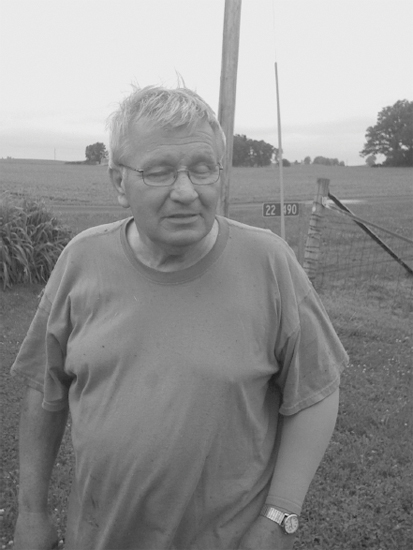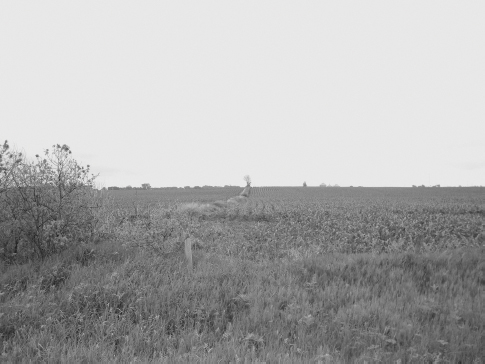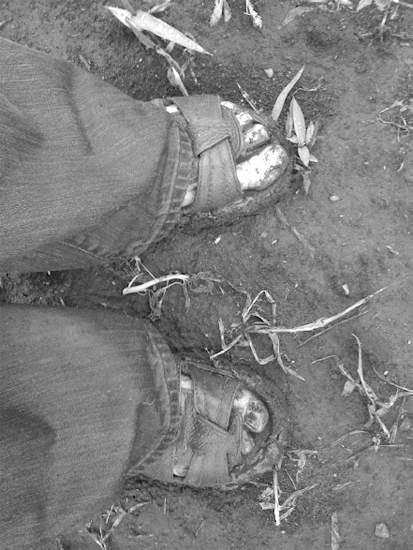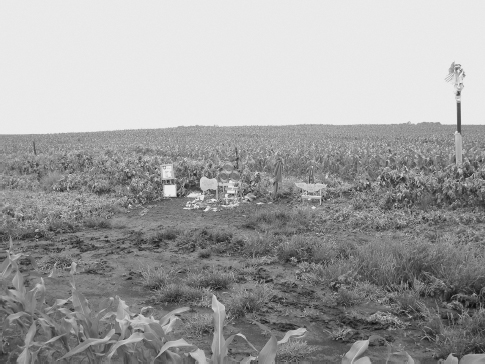
Keith Mastre. Iowa farmer. Retired. Author
I was off and running. I just needed to follow the magic blue line 5.3 miles until there was no more blue line. A few minutes later I ran out of blue line and stopped.
I was there. But . . . where was I?
On my left was a farmhouse. A man in a blue T-shirt was using a weed-whacker along his fence. He looked up and I smiled and waved. He pointed to the other side of the road. I turned and looked to see a cornfield with an old barbed-wire fence running away from the road. I looked back at the man and did my best to ask a question with the puzzled look on my face. He lifted his arm and pointed again down the fence line.
He’d seen this movie before.
I pulled over and parked on the side of the road and climbed out of my car. I felt awkward, but walked across the road. “Hi there,” I said in my friendliest voice.
“Just follow that fence line about half a mile. You’ll see it,” he replied.
I extended my hand and he took it. “I’m Gary Moore. I’m an author.” I had no idea why I told him I was an author. “Keith Mastre,” he responded, still gripping my hand tightly. “I’m a farmer.” He smiled. “Retired.”

Keith Mastre. Iowa farmer. Retired. Author
“Is he mocking me?” I wondered. “How long have you lived here, Keith?” I asked.
“All my life.” The retired Iowa farmer turned to his right and pointed to a house that was being rebuilt. “I was born and raised over there. When I married, my wife and I built this house,” he continued, pointing to the home directly behind him.
“When I drove up you pointed across the road,” I said.
He looked straight at me a few seconds—and I mean right in my eyes. “That’s why you’re here, right? Why else would you come down this road?”
Of course I knew exactly what he meant. “Yeah, I guess you’re right,” I answered. I looked back down the fence line. It was deathly quiet. “Did you live here the night of the crash?” I asked.
“Oh yeah,” Keith said and nodded. “I was a freshman in high school. I was a fan of Buddy, but didn’t get to go to the Surf that night. Farm chores,” he explained with perhaps a twinge of regret in his voice. “The plane ended up about half a mile from here. Ours is as close as any other house, I guess. We didn’t hear anything, though.”
“Keith, do you remember what the weather was like that night?” I asked
“There was one heck of a snow squall that started after midnight,” he answered. “It didn’t last too long, though. That’s what my dad said. Visibility was poor.”
“How did you learn about the crash?” I inquired. “When did you hear about it?”
“It was the next morning. I got up to catch the late bus for school and people began showing up and turning into the field,” he answered. “Police. Emergency vehicles. Dad walked a few yards out into the field. Said he could see what he thought was an airplane. That’s all. We had no idea who was in it.” Keith stopped talking and it was only then that I realized he was staring straight down that fence line as though he was looking for that plane even now.
“So you didn’t go and take a look?”
“No,” he replied quickly and firmly. “Dad wouldn’t allow it. I’m glad now.” Keith lowered his eyes and looked down at the ground. His emphasis on the word now made it clear to me he had not been as pleased with his dad’s decision in 1959. “I hear from those who did go that it was an ugly mess. We learned in school that day what happened. We couldn’t believe it happened in our town. All three of them,” Keith continued. “Well four, including the pilot. They died here in Iowa. They almost died on my front lawn.”
We both stood there, staring down that fence line as if we were watching the final events of that early February morning unfold all over again.
“There was no foul play,” Keith offered. “You know, all the rumors about what happened in the plane? No one was shot. There was a snow squall, simple as that. My dad couldn’t see through it, so imagine a pilot going over 150 miles an hour. What is he going to see?” Keith asked.
“A white blur?” I offered.
“Exactly.”
“You know, the Weather Channel refers to this crash as one of the top 100 weather moments in history,” I said.
He didn’t respond, and there really wasn’t a need to answer. We both stared down the old fence line, a retired farmer and a stranger bound together by events that took place more than five decades earlier.
The wheels in my mind began to spin. I pictured men yelling to one another, but could not make out what they were saying. A police car pulled up, wheels spinning and the back end sliding from side to side in the snow-covered field. My heart began racing.
Keith interrupted the movie playing in my head. “A few days later, it was over. I thought it was back to being a cornfield one year and a bean field the next, but no.” His voiced softened. “It had all changed.” Keith looked down at his work boots and lifted the left one to look at the mud stuck to its sole.
“What . . . changed?” I asked.
“They started coming almost immediately,” he answered. “They’d take a walk down that fence line, and for what? From all over the world they came. Every nationality. To see what? They still come from all over—fifty-plus years later, they are still coming.” He furrowed his brow and looked at me as if wanting an explanation.
I didn’t really have one. What was I going to say? That I hadn’t really heard of Buddy Holly, but I went to a show in Cedar Falls and this guy named John who looks like Buddy played a song about Buddy and . . . and what? I decided to keep quiet.
“Look at you. You’re here now. Can you tell me why?” Keith asked.
I shrugged. “No. Not really. I have asked myself that question over and over. I was even wondering that as I drove out here.” I thought for a moment before continuing. “I’d like to say I’m here for my profession. I’m writing about it, but it’s become . . . well, let’s just say it’s become something more than that.” I turned to look back down the fence line. “So much more.”
“See what I mean?” Keith continued. “It’ll never be just a cornfield again.” No elaboration was necessary.
“May I take your picture?” I asked, lifting my iPhone chest-high. “Assuming I ever finish this manuscript, maybe we can use it in the book. Would that be alright with you?”
“Sure,” he answered. I snapped it quickly.
“When was the last time you walked down there, Keith?” I asked.
“Never.”
The single word answer stunned me. “Wait. You’ve never walked down there? Not days after the crash as a high school student? Not ever?” I was not sure I believed him. He shook his head. I asked again. “You’re telling me that since February 3, 1959, you have never walked the half-mile down the fence line to the crash site?”
“Right. That’s what I’m telling you.” He shot me a quizzical look as if wondering why I would doubt him.
I slowly shook my head. “People come from all over the world to this place and you have never walked across the road to see it.” I think I said those words out loud more for my own understanding than anything else. I shrugged and looked back down the fence line. “Okay, well. I’m going.”
“Of course you are. That’s why you came. So go take a look and let me get back to all my work,” he said with a wide and warm Iowa smile.
I turned to walk away and then turned back. “Want to come with me, Keith?” I asked, my eyebrows raised high in the faint hope he might say yes.
He was silent for a couple seconds. “No. You go. I have work to do. There’s nothing there but sadness.” He made a brushing motion with his hands as if to shoo me away.
I thanked him for his kindness and turned and walked across the country road between Keith’s home and the infamous field. He lived here all these years and had never visited the site, but I was being drawn to it. I felt it. I couldn’t not go—even if I tried to resist. But drawn there by what? A song?
I turned back and spotted Keith on his garden tractor heading for his house. I looked at my car. “Should I just climb in, turn the key, and leave?” I wondered aloud. No. I had to take the walk. What was I waiting for? Why was I stalling? I think I was looking for a reason not to go.
I took a deep breath and walked down into the ditch and back up the other side and entered the cornfield at the fence line. The fence was made of old barbed wire, knee high in a few spots and lying on the ground in others.
It had rained off and on all day and was beginning to drizzle again. Judging by the look of the old rusted wire and mixture of rusty steel and old wooden posts, they had been here a long time. Did they date from the time of the crash? Was this the original fence and a lifeless witness to the stars that fell from the sky shortly after midnight on February 3, 1959?
I reached down and touched the barbed wire as though I was touching something important . . . something precious.
I was wearing blue jeans, a black T-shirt, and, unfortunately, sandals. I took the first couple of steps and I sank ankle-deep in black Iowa mud. I turned to look back at Keith, but he was gone. A shiver of embarrassment coursed through me and I said aloud, “He thinks I’m nuts.” I looked down the fence line and saw nothing but fence. I looked down and could not see my feet below the mud. “And he’s right. I am.”
“Is this the right place?” I wondered. The rain drops came down a little harder. I had read somewhere online that there was a marker . . . a large pair of glasses at the entrance to the field. I looked back. There are no glasses. Keith wouldn’t have sent me on a wild goose chase, would he? Maybe I was entering from the other side of the field. I kept going.
I contemplated walking a few inches from the fence where there was some grass, but I was in thin sandals and the barbed wire was on the ground as much as it was strung between the fence posts. I was about to give it a try when I realized I hadn’t had a tetanus shot in years. I decided to stay in the mud. I pulled one foot out, put it in front, and watched as it sank into the ground as I yanked out the other and repeated the process. The mud especially liked my left sandal, which insisted on remaining behind each time I lifted my foot. I kept moving. The rain kept falling.

Keith Mastre and I stood on the edge of the country road staring down this old fence line (center distance). A little more than one-half mile from this point, the Beechcraft Bonanza came to rest against this very fence after cart-wheeling across the field (from right to left), leaving a 570-foot debris field in its wake. Author
After struggling about one-quarter of a mile I stopped to study the lay of the land. Nothing ahead. I looked back toward my car. I couldn’t even see it because of the the corn, which varied between knee- and waist-high. I drew a deep breath and exhaled. It took a lot of energy to wade (and that is really what I was doing—walking is a charitable description) through ankle-deep mud. A loud clap of lightning broke somewhere in the distance and a few seconds later the rumble of thunder reached my ears. The rain came down even harder. I was already soaked to the skin.
“Perfect!” I shouted in frustration. “This is just perfect!”

My sandals—at the beginning of my trek to the crash site. Author
I had to keep going. I yanked out my left foot and left my sandal behind. Again. I reached down to find it and slip it back on. The mud was the blackest and richest soil I had ever seen. I took a few more steps and said to myself, “It should be. It was fertilized with the lives of four young men.” That odd thought really creeped me out.
What made me think of that?
I finally spotted something up ahead. It looked like flowers on a fence post maybe? I wasn’t really sure. I turned and looked back toward the road, shook my head, and looked ahead once more. I alternated between walking (or rather, stumbling) and wading a few more minutes and then stopped dead in my tracks.
My pulse rate increased.

“I’m here.”